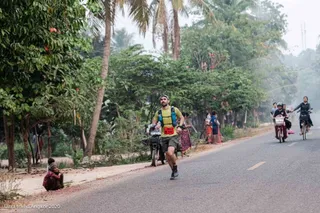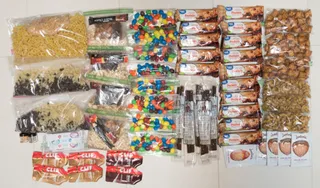This is the first of a 4 part series on nutrition for endurance athletes. Subscribe for updates as we drop other articles:
- Fueling and Nutrition for Marathons, Ultras and FKTs
- Race Strategy Nutrition for Ultramarathons (congrats, you’re here!)
- Common Foods for Marathons, Ultramarathons and FKTs
- Ask Me Anything: Food and nutrition Q&A for runners
Many of my ultramarathon athletes have approached me, ‘How do I even eat for an ultramarathon race?’ This is one of those existential questions akin to your child asking who is God.
This article exists to put what is a very complex topic of race nutrition into a succinct and digestible (get it?!) guide.
Endurance Nutrition Strategy – What should I worry about?

Runners have four important yes/no questions that will guide a nutrition plan:
- Does food generally sit well in my stomach?
- Is my event longer than 8 hours?
- Am I bringing my own food or relying on aid stations?
- Will race conditions differ from how I’ve practiced in training?
Poor nutrition and hydration cripples running performance in an ultra. That is a scary thought, especially if that is a new distance. Using these questions…
If I have an iron stomach, I believe I am at a lower risk of GI distress or nausea from eating the wrong foods.
If my event is over 8 hours, I’m exerting less acute stress on my body and therefore am less likely to experience stomach issues.
If I can supply my own food in a race, I can ensure that I’m bringing safety foods that I know I will respond positively to.
If a race has temperatures over 70 degrees, is humid or dry, at altitude or a runnable course, my body will likely respond differently than it has in training.
A common mistake I see in ultrarunning is for runners to extrapolate the results of their longest last run to project for this race. Just because you ran slow for 4 hours once doesn’t mean your body will respond the same way under more trying conditions for twice the duration. Develop a broader scope of data, and then get back to bragging to your friends about your iron stomach.
If you lack experience, have a gameplan but don’t be afraid to stray from it. While the principles outlined below will help you maximize your performance, people have finished ultras with a lot less foresight. Until we turn into psyborgs, nutrition will be an art, not a science. Don’t be intimidated.
Principles of Ultramarathon Nutrition

Ultrarunners read and hear conflicting nutritional advice on race day. There are complex rules, superfoods and burritos. Is it really an ultramarathon if you didn’t eat a burrito at an aid station?
- 150-250 calories per hour: Significant research has been done to quantify the ideal amount of calories per hour to digest. Eat more and you will likely experience GI distress, eat less and you are increasing your chances of bonking or ‘hitting the wall.’ However, some studies show mountain runners are able to digest up to 460 calories per hour. While not everyone will be able to handle this much, try eating more if 250 cal/hr is comfortable for you.
- Eat carbs: Carbohydrates are the rocket fuel of the metabolic system. Proteins and fats require a more complicated breakdown in your stomach, where a simple carb can be digested, converted to energy, and use by muscles within ~20 minutes of entering the body.
- In races of 6+ hours, I recommend eating 15% of calories from proteins to supplement the carbohydrates.
- In races of 12+ hours, I find the body to be more capable of digesting fats.
- Hydration and electrolytes: Drink to thirst and incorporate electrolytes (I prefer salt tabs over a product like Nuun) into your race strategy. A potentially complex topic, read here for more.
- Nothing new on race day: Try a lot of diverse foods in training and find what sticks. Like anything, nutrition is personal.
- Develop a plan: Research the race course, predict time between aid stations, create calorie goals between aid stations, decide how much you plan to bring/eat at aid stations, andddddd race!
- Fitness vs. nutrition: Ultrarunners are often limited by their nutrition/hydration/race strategy rather than their fitness. If you had low points in a race, you were more likely limited with the amount of glucose you have burned through in your muscles rather than a lack of fitness. This is especially common in newer runners. It took me 4 ultras to realize my ‘late race fatigue’ was actually nutrition related.
I wish someone had sat me down and had ‘the talk’ when I first got into ultramarathons. These principles will put you on a much quicker trajectory to take on faster or longer ultras.
Considerations for 24+ hour events

For multi-day races or FKTs, replenishing your full caloric stores should be a priority. Having extensive experience in multi-day events, I want to address a topic. Some multi-day athletes believe in the strategy to operate in an extreme caloric deficit to…
- Limit the weight of carried food in self or unsupported runs. Every 2,000 calories of food equals approximately 1lb, which can be a big deal if you are carrying 5 vs. 15lb of food over 5 days.
- Simply their strategy. Less food = less planning = less potential stomach issues
- Utilize their fat burning system and decrease bodyweight. By burning fat at a high caloric deficit, athletes can lose 10-15lb over the course of a few weeks, theoretically ‘lightening the load.’
However, in my experience, if you are serious about performance, this is a losing strategy especially over longer time frames. When I am talking longer time frames, I think of ‘short’ multi-day efforts (24-96 hours), ‘medium’ multi-day efforts (4-14 days) and ‘long’ multi-day efforts (14+ days). While you can get away with a caloric deficit for a few days, it is going to severely limit performance due to the lack of available glycogen which is essential to performance. Additionally, your metabolism takes time to adjust to burning 6,000-13,000 calories per day. Most runners find it very difficult to match caloric intake with caloric burn over the first few days and therefore pack less. However, that begins to change after a few days and really changes after a week or two.
Data on this is scarce, however in working with researchers on caloric expenditure (I’ll write about studies when they’re published), I’ve put together a few rules of thumb. First, use Basal Metabolic Rate (BMR) as your baseline number. This is the amount of energy your body burns per day at rest. Calculate here. My BMR is 1,822 cal/day. Second, these caloric intake suggestions is highly subjective based on your exercise intensity level, age, gender and more. See suggestions below:
- ‘Short’ multi-day efforts (24-96 hours): The ‘time-on-feet’ sweet spot for most runners in this distance seems to be around 85-95% of their time is spent moving (or ~20-23 hours). If you are maxing out your effort in a short race, you are likely burning between 8,000-13,000 calories. In daily life, active athletes burn between 2,500-4,000 calories per day and your metabolism won’t be able to make the jump from consuming 2,500 calories in a day to 8,000. Set caloric goals at x2-3 your BMR calculated above.
- For me, that would be between 3,644-5,466 cal/day.
- In a 24 hour race, I typically consumer 4,000, while over the first few days of the Arizona Trail, I consumed 5,500 calories per day.
- ‘Medium’ multi-day efforts (4-14 days): Expect to burn between 7,000-11,000 calories, but, similar to ‘short’ efforts, your metabolism won’t catch up to your burn for the first few days. Over the first few days, aim to eat x2-3 your typical daily caloric intake, building to x3.5-4.5 your daily caloric intake.
- For me, x3.5-4.5 would be between 6,377-8,199 cal/day.
- For athletes I’ve worked with, anyone who reported less than 6,000 (6-8.5k being the range) had notable energy issues on a medium length effort.
- On the Long Trail, over 5 days, I averaged 6,500 cal/day
- On the AZT, over 13 days, I was burning an average of 10,400 calories per day and consuming an estimated ~8,000 calories per day.
- ‘Long’ multi-day efforts (15+ days): Follow the recommendations for the ‘Medium’ length efforts. Your metabolism will adjust to energy expenditure over the first two weeks. You’ll have established a habit of under-eating compared to your caloric burn. If you run in a caloric deficit for too long, you will lose a lot of weight and your energy levels will seriously limit your progress. After ~10 days, plan to eat between x4.5-6. your daily caloric intake, or between 6,000-10,000 calories.
- On the latter half of my 45 day Appalachian Trail FKT, I estimated I was consuming between 9,000-11,000 calories per day. Anything less would leave me noticeably hungry and fatigued.
- While I don’t have calorie calculations on the Pacific Crest Trail FKT, I would regularly eat 2,500+ calories once I got into camp.
Develop a Plan for Race Day

If you fail to plan, you plan to fail. – Benjamin Franklin
Nothing more true can be said of ultramarathon nutrition. If you are asking yourself the right questions and have the basic principles of race nutrition down, you need to put it together with a race strategy. ‘But Joe, I just want to finish and have fun! Do I really need a plan?’
- Find out general specs of the course: Distance, elevation gain/loss, an elevation profile, estimated high/low temps, or any other information you can gather. This is best found on the race website, by looking at past participants race reports or Strava, and Google for odds-and-ends.
- Set goals: I challenge my athletes to create an A, B and C goal. Why are you out here? What will drive you to the finish? Create at least two time goals.
- Create a race profile: Often this is done by the race organization. Identify aid stations/resupply points and calculate distances between aid stations. Having an elevation profile visual is great.
- Create nutrition plan: How many calories are you trying to eat per hour? Use your goal paces to estimate the amount of time it will take for you to get between aid stations. With this information, you can estimate how many calories you need to eat between aid stations. Then, you can estimate how many calories you plan to eat from aid stations, leave in drop bags or carry on your person.
- Race and review: Execute your plan to the best of your ability. Afterwards, did you follow your nutrition plan? What worked and what didn’t? How many calories did you average per hour?
If you are racing for a multi-day event, you may get overwhelmed by the amount of food you are trying to plan for. Rather than thinking about caloric intake per hour, I like to think of daily caloric goals and go from there.
Final Thoughts

Every runner has a different nutrition strategy, and you may find certain tips and tricks that work for you. Even has someone who has completed in a lot of ultramarathon efforts, I’m still learning and progressing as an athlete. You’ll find that your desires and limitations change over time. If you can walk away from this with two things, they are:
- Ask yourself the right questions about the race course.
- Develop a plan.
And don’t worry about ‘messing up’ or ‘eating the wrong foods.’ Every person has different needs that will dictate their own approach. There is no one-size-fits-all model. Your training and race experience will help you shape your nutrition plan, so always be practicing!
This is the first of a 4 part series on nutrition for endurance athletes. Subscribe for updates as we drop other articles:
- Fueling and Nutrition for Marathons, Ultras and FKTs
- Race Strategy Nutrition for Ultramarathons (congrats, you’re here!)
- Common Foods for Marathons, Ultramarathons and FKTs
- Ask Me Anything: Food and nutrition Q&A for runners
This post contains affiliate links. I earn a small commission on sales via these links at no additional cost to you. If you'd like to support me, please purchase products through the affiliate links. Thanks!




Thank you for sharing this. Found this very helpful as a muscular endurance runner.
Awesome, glad this is helpful for you! Based on observation, it seems like folks with more a build need to pay extra attention to nutrition and hydration. Get after it!
Reading your article reminded me of what I need to think about in preparation for my upcoming 100 miler. Thanks for helping me brush off the cobwebs.
Best of luck!!
Hey Joe, I don’t want or need to be posted in the comments but you might be interested in the book titled Burn. They did extensive research on BMR, calories in and calories out. Interesting research, some of it is exactly inline with your article above. A couple applicable findings are:
Body can’t use more than 2.5 bmr to cover massive calories burned.
Our body adapts and keeps your calories burned within 600+/- of BMR.
Happy trails.
Great comments! Yes, I am a big fan of Burn and Hermann Pontzer. I’ve actually collaborated with him a few times in helping gather research on ultra endurance for his science! I think the most interesting component of this research is that there is a regression analysis of endurance events, and depending on the length of the event anywhere from ~x10 BMR to x2.5 BMR is right around the upper limit that endurance athletes can sustain. Very cool research!